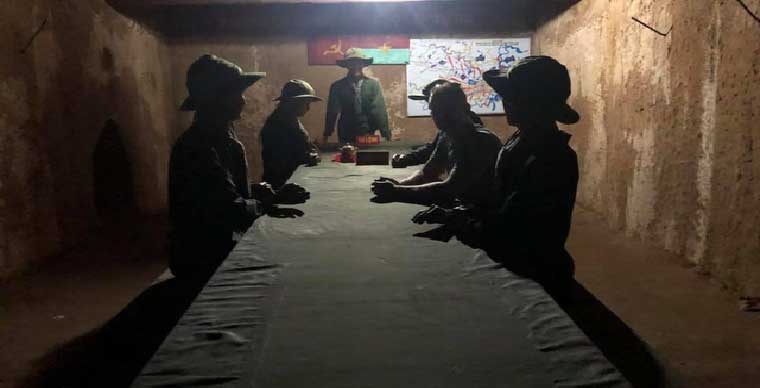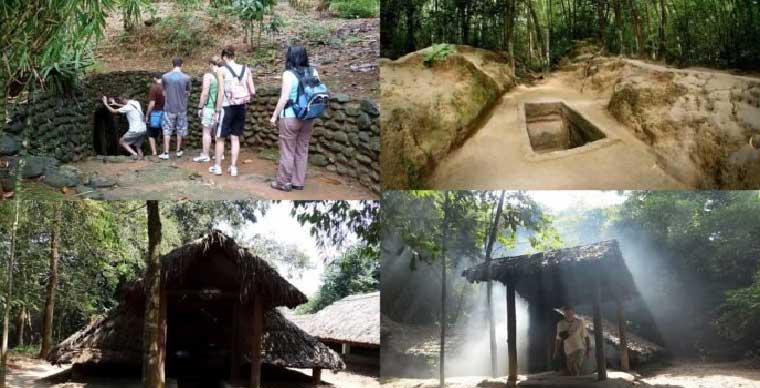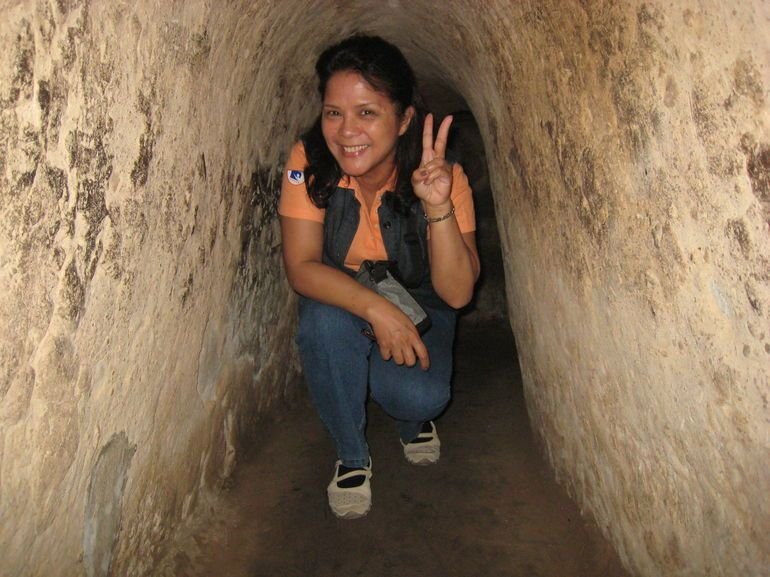
The Cu Chi Tunnels are a vast network of underground tunnels located in Vietnam, historically significant for their role during the Vietnam War. These tunnels served as a vital lifeline for the Viet Cong, giving them the ability to conduct guerrilla warfare against American and South Vietnamese forces. Beyond their military importance, the Cu Chi Tunnels symbolize resilience and ingenuity in the face of overwhelming odds.
1. Introduction to the Cu Chi Tunnels

The Cu Chi Tunnels, situated around 70 kilometers northwest of Ho Chi Minh City, form an intricate labyrinth that stretches for over 250 kilometers. Originally constructed during the French colonial period, these tunnels were expanded significantly during the Vietnam War, providing shelter, supply routes, and operational bases for the Viet Cong forces.
Initially used as hiding spots from French colonial troops, the tunnels became increasingly relevant as the conflict with the United States escalated. The network was strategically planned to provide critical advantages in terms of mobility, concealment, and surprise attacks against enemy forces. In essence, the Cu Chi Tunnels are not just a historical site; they represent the spirit of resistance and adaptability of the Vietnamese people during times of war.
2. Historical Significance of the Cu Chi Tunnels

The significance of the Cu Chi Tunnels extends far beyond their physical presence. They serve as a poignant testament to the resilience and ingenuity of the Vietnamese people during the Vietnam War. From a military perspective, the tunnels were a strategic masterpiece, allowing the Viet Cong to evade capture, launch surprise attacks, and effectively counter the superior firepower of the American forces. The intricate network of tunnels, complete with underground hospitals, kitchens, and living quarters, showcased the resourcefulness and adaptability of the Vietnamese fighters.
Socially, the Cu Chi Tunnels symbolize the collective effort and sacrifice of the Vietnamese people. The tunnels were not just a military tool but also a lifeline for countless civilians who sought refuge and support during the war. The tunnels became a symbol of resistance and unity, fostering a strong sense of community among the Vietnamese people.
Culturally, the Cu Chi Tunnels represent a significant chapter in Vietnamese history. They are a reminder of the hardships and triumphs experienced by the Vietnamese people during the war. The tunnels have become a popular tourist destination, attracting visitors from around the world who come to witness firsthand the remarkable engineering and historical significance of this underground network.
2.1. Role in the Vietnam War
As the Vietnam War raged, the Cu Chi Tunnels became a focal point for the Viet Cong’s guerilla tactics. They allowed combatants to remain hidden while launching surprise attacks on American and South Vietnamese troops stationed above ground. The complexities of the tunnel system meant that soldiers could move without being detected, evade capture, and regroup after skirmishes. This contributed greatly to the prolonged nature of the conflict, demonstrating the efficacy of guerrilla warfare strategies.
2.2. Symbol of Resistance
The Cu Chi Tunnels also hold deep symbolic value in Vietnamese national identity. For many, they epitomize the struggles endured by the Vietnamese people during decades of conflict. The tunnels serve as a testament to the resourcefulness of a nation that faced enormous challenges yet emerged with a renewed sense of unity and purpose. This aspect of the tunnels has made them a central theme in discussions about resilience and nationalism.
2.3. Legacy and Commemoration
After the war, the Cu Chi Tunnels were preserved as a historical site to educate future generations about the hardships faced by those who lived through the conflict. Today, they stand as a reminder of the consequences of war, honoring the sacrifices made by both soldiers and civilians alike. The tunnels offer insight into the human experience during turbulent times and continue to invoke deep emotional responses from visitors worldwide.
3. The Construction of the Cu Chi Tunnels

Constructing the Cu Chi Tunnels was no simple task. It involved a combination of innovation, determination, and sheer willpower. As we delve into the construction process, we can appreciate the strategic foresight of the Viet Cong. The tunnels were meticulously carved out of the earth, utilizing traditional tools and techniques. The Viet Cong soldiers, often working under the cover of darkness, meticulously dug and expanded the tunnels, creating a labyrinthine network that extended for miles.
3.1. Materials Used in Tunnel Construction
One of the remarkable aspects of the Cu Chi Tunnels is the choice of materials utilized in their construction. The primary building blocks were locally sourced, often utilizing the earth itself. The soft soil found in the Cu Chi region made it relatively easy to dig, allowing for extensive networks to be carved out.
In addition to dirt, the builders ingeniously employed discarded materials from bombed-out structures, taking advantage of resources that would otherwise go to waste. This not only showcased the resourcefulness of the Viet Cong but also highlighted the dire circumstances in which they operated—a necessity to survive in a war-torn environment.
3.2. Techniques Employed by the Viet Cong
The techniques used to construct the tunnels reveal much about the creativity and tenacity of those who built them. Workers labored under the cover of darkness, avoiding detection by enemy forces. Using hand tools such as shovels and picks, they dug tirelessly, often working in shifts to expand the network rapidly.
Moreover, architectural features such as ventilation shafts, trapdoors, and booby traps were incorporated into the designs. These elements were crucial for maintaining air quality inside the tunnels while also ensuring the safety of those residing within. This strategic thinking reflects a profound understanding of both military tactics and engineering principles.
4. Life Inside the Cu Chi Tunnels

Life within the Cu Chi Tunnels was far from idyllic. The tunnels were cramped, dark, and humid, and the constant threat of discovery by enemy forces added to the psychological stress. However, the inhabitants of the tunnels were forced to adapt creatively to their surroundings. They developed innovative ways to maximize the limited space, constructing makeshift living quarters, kitchens, and medical facilities. The tunnels were also equipped with ventilation shafts and drainage systems, which helped to improve air quality and prevent flooding.
4.1. Daily Activities and Survival Strategies
Daily life in the tunnels revolved around survival and sustenance. Due to the cramped quarters, families often had to work closely together, fostering strong bonds amidst adversity. Cooking, sleeping, and living all took place in small, confined spaces where every inch mattered.
Food sources primarily consisted of what could be grown in secret gardens or obtained from local markets. Strategies included rationing supplies and scavenging whenever possible. The Viet Cong developed ingenious ways to camouflage their cooking fires, ensuring they did not attract attention from overhead aircraft.
4.2. Psychological Challenges
The psychological toll of living underground cannot be overstated. Many tunnel residents experienced anxiety due to the constant threat of discovery, bombardment, and starvation. Fostering a sense of community became essential, as sharing experiences and supporting one another helped alleviate some of the mental strain.
In addition, the tunnels sometimes served as escape routes during raids, leading families to frequently relocate within the complex network. This lack of stability, while part of survival, added another layer of stress to an already challenging existence.
4.3. The Role of Women and Children
Women played a crucial role in the tunnels, taking on various responsibilities that went beyond traditional gender roles. While men engaged in combat, women often managed the household, cared for children, and participated in agricultural activities. Their contributions were vital for sustaining families and supporting the war effort.
Children, too, were affected profoundly by life in the tunnels. Many were born underground, growing up knowing nothing other than the sounds of conflict. Education often took place in makeshift classrooms, where lessons focused on survival skills, history, and ideology. These formative experiences instilled resilience and a strong sense of purpose in the younger generation.
5. Military Strategies and Operations

The Cu Chi Tunnels were not merely hiding places; they functioned as essential components of a broader military strategy. The Viet Cong leveraged the unique characteristics of the tunnels to enhance their operations. These subterranean networks served as vital communication channels, allowing the Viet Cong to coordinate attacks and share intelligence across vast distances. The tunnels also facilitated the movement of troops and supplies, enabling the Viet Cong to outmaneuver their adversaries.
5.1. Guerrilla Warfare Tactics
Guerrilla warfare was defined by its emphasis on mobility, surprise attacks, and the ability to exploit an opponent’s weaknesses. The tunnels enabled Viet Cong fighters to launch sudden assaults on larger enemy forces before retreating underground, vanishing without a trace. This tactic demoralized opponents, forcing them to remain vigilant while attempting to maintain control.
The tunnels also facilitated the establishment of ambush points, where Viet Cong fighters could lure unsuspecting enemy patrols into traps. These calculated maneuvers disrupted supply lines and created chaos, highlighting the effectiveness of unconventional warfare.
5.2. Major Battles Involving the Cu Chi Tunnels
Several significant battles throughout the Vietnam War hinged on the strategic advantages offered by the Cu Chi Tunnels. Notable clashes included the Tet Offensive, which saw coordinated attacks across South Vietnam, including areas surrounding Cu Chi. The element of surprise, coupled with the effective use of the tunnels, led to notable victories for the Viet Cong.
Another example is the Battle of Cu Chi, where U.S. troops sought to dismantle the tunnel system. Despite overwhelming firepower, the Viet Cong’s intimate knowledge of the terrain and underground passages allowed them to evade capture effectively.
6. The Cu Chi Tunnels Today

In contemporary society, the Cu Chi Tunnels have transitioned from a site of conflict to a symbol of resilience and remembrance. Preservation efforts are underway to maintain their historical integrity. The tunnels have been transformed into a poignant war memorial, attracting visitors from around the world who come to pay homage to the sacrifices made by the Vietnamese people. By preserving these underground networks, we ensure that future generations can learn about the hardships and triumphs of the past. The Cu Chi Tunnels stand as a testament to the human spirit, a reminder of the strength and determination that can emerge in the face of adversity.
6.1. Preservation and Restoration Efforts
Efforts to preserve the Cu Chi Tunnels began shortly after the end of the Vietnam War. Recognizing the importance of this site, both nationally and globally, restoration projects aimed at stabilizing the tunnels and ensuring they remain accessible to future generations were initiated.
Local organizations, along with international support, have worked diligently to protect the tunnels from deterioration caused by environmental factors and tourism. These initiatives ensure that this significant piece of history remains intact and continues to tell the story of those who once lived there.
6.2. The Role of Tourism in Education
Today, the Cu Chi Tunnels serve as a prominent tourist attraction, drawing visitors from around the world. Guided tours educate tourists about the historical context of the tunnels, letting them step into the shoes of those who inhabited the complex network. This educational aspect fosters cross-cultural understanding and provides a platform for discussion about the impacts of war.
However, the influx of tourists must be balanced with preservation efforts. Sustainable tourism practices are essential to prevent damage to the tunnels while still allowing for meaningful engagement with history.
7. Visiting the Cu Chi Tunnels

For those eager to explore the Cu Chi Tunnels, preparation can enhance the experience immensely. Understanding what to expect and how to navigate this historical site can make for a more enriching visit. Before embarking on your journey, it’s advisable to research the different tour options available, as well as the specific sections of the tunnels that you wish to explore. Some tours offer a more comprehensive experience, including visits to various tunnel complexes and historical exhibits.
7.1. How to Get There
Located approximately 70 kilometers from Ho Chi Minh City, reaching the tunnels typically involves a short drive. Visitors can choose between organized tours or independent trips by taxi or motorbike. Various tour operators offer packages that include transportation, guides, and additional historical insights.
It’s advisable to plan your visit ahead of time, considering peak tourist hours to avoid overcrowding. The journey offers glimpses of rural Vietnam, showcasing a different side of the country away from bustling urban centers.
7.2. What to Expect During Your Visit
Upon arrival, visitors will find themselves immersed in a rich historical narrative. The entrance to the tunnels often features displays that explain their significance and role in the Vietnam War. Tour guides typically provide context and personal stories, enhancing the experience through firsthand accounts.
Exploring the tunnels requires caution, as some sections are narrow and dimly lit. Visitors might also encounter exhibits illustrating the daily lives of those who lived underground, further contextualizing the historical significance of the site.
Experiences like crawling through designated sections of the tunnels allow guests to gain a tangible sense of what life was like underground, while also fostering empathy for those who endured those conditions for extended periods.
8. Cultural Impact of the Cu Chi Tunnels
The Cu Chi Tunnels extend beyond their physical presence; they embody cultural narratives deeply woven into the fabric of Vietnamese identity.
8.1. Representation in Media and Literature
The Cu Chi Tunnels have inspired numerous works of art, literature, and film. Documentaries often highlight the ingenuity and resilience associated with the Viet Cong while depicting the harsh realities of life in the tunnels. Novels exploring the Vietnam War frequently reference the tunnels as emblematic of the struggle faced by the Vietnamese people.
These representations contribute to a broader understanding of the war, ensuring that the complexities of the conflict are remembered rather than overshadowed by simplistic narratives. Moreover, artistic interpretations enable audiences to connect emotionally with the past, deepening appreciation for the triumphs and tragedies experienced.
8.2. Symbolism in Vietnamese National Identity
Within Vietnam, the tunnels play a significant role in shaping national identity. They evoke themes of perseverance, courage, and resistance against foreign aggression—qualities highly valued in Vietnamese culture.
National commemorations and events frequently reference the Cu Chi Tunnels, reinforcing their status as symbols of pride. Such recognition fosters a collective memory that honors the sacrifices made during the war, instilling a sense of unity among Vietnamese citizens.
Xem thêm: Vietnam Motorbike Tours: Discover Landscapes and Culture
9. Conclusion
Life inside the Cu Chi Tunnels encapsulates a poignant chapter in Vietnamese history, revealing the extraordinary resilience of individuals living in dire circumstances. From their construction to their evolution as a symbol of national identity, the tunnels exemplify human ingenuity and determination. As we reflect on the legacy of the Cu Chi Tunnels, we acknowledge the enduring spirit of those who fought for their homeland and the lessons learned from their incredible journeys.
Through education, preservation, and cultural representation, the Cu Chi Tunnels continue to resonate with audiences today, inviting exploration and understanding of a complex historical narrative deeply entwined with human experience.
OTravel Vietnam | Ready to Start Your Adventure in Vietnam
• Phone: (+84) 816 616 466 (WhatsApp/ Zalo/ Viber)
• Email: OTravelVietnam@gmail.com
• Website: www.otravel.vn
• Facebook: facebook.com/OTravelVietnam / facebook.com/OTravelcom
At OTravel Vietnam, we provide seamless travel solutions to help you explore the beauty of Vietnam. From personalized tours to unforgettable experiences, we ensure every journey is memorable. Contact us today and let your adventure begin!”







